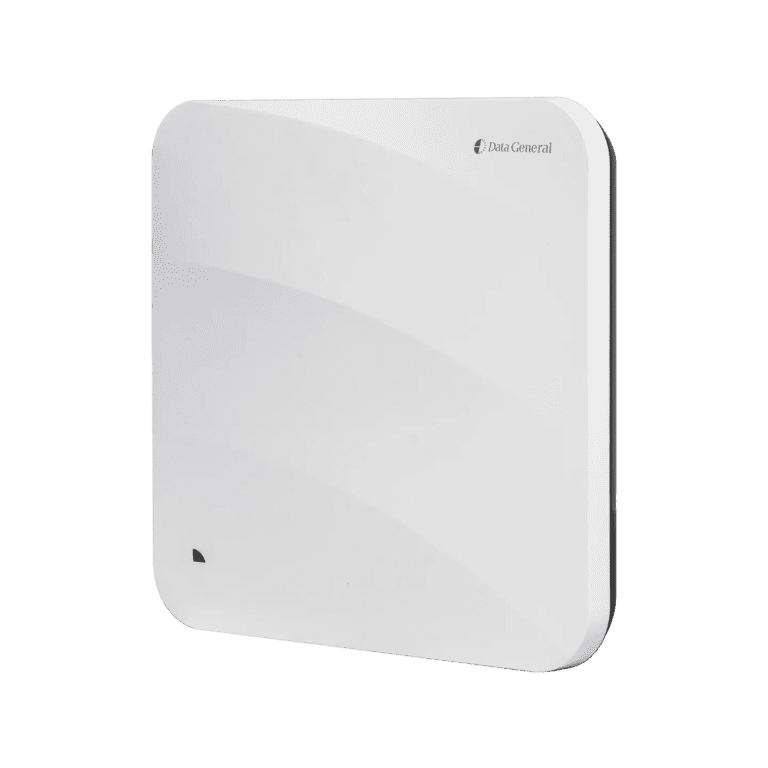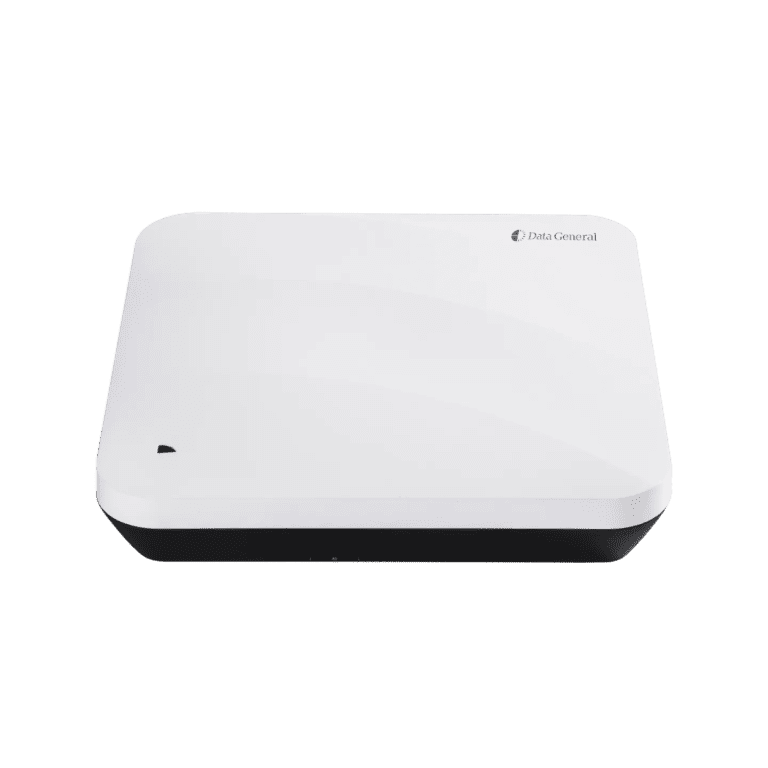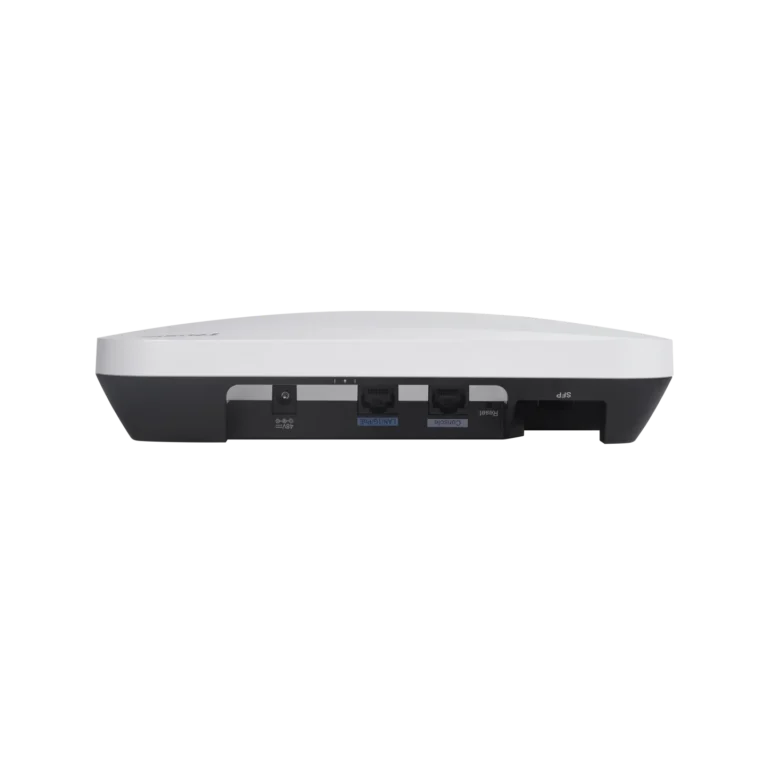WiFi 6 dual radio 2x2 3000 Mbps Access Point
DG-AP820-AX3000
- 2976 Mbps aggregated
- WiFi 6 802.11ax
- Dual 2.4 GHz and 5 GHz radio
- Four Spatial streams: 2x2 and 2x2
- RJ45 1 Gbps and SFP 2.5 Gbps ports
- Up to 256 STA (users)
No wonder it's our top-selling WiFi 6 access point!
The incredible price/performance ratio and performance of the Data General DG-AP820-AX3000 Access Point, coupled with its aggregate wireless speed of 2976 Mbps, make this 2×2 dual-stream dual-radio WiFi 6 Access Point the most demanded alternative in any installation. In addition, it incorporates a Gigabit RJ45 port and a 2.5 Gbps optical SFP combo port, which allows it to be an access point capable of connecting over fiber optic cable distances of more than 100 m. from the switch and also to be used in GPON installations (with the appropriate connection module).
This 802.11ax access point is ideal for installations in offices, classrooms, hotels, hospitals, residences, homes,.. . and any indoor space that requires a secure, stable and fast network connection.




- Protocols: 802.11a/b/g/n/ac/ax WiFi 6.
- Dual radio: 2.4 GHz (2×2) and 5 GHz (2×2).
- Aggregate speed of 2976 Mbps.
- 1 RJ45 1Gbps port, 1 SFP combo 2.5 Gbps port.
- Quality of Service (QoS) management.
- Up to 256 STAs (devices) and 32 virtual APs.
- Power over PoE (802.3at) or external power supply (48v. 0.6 A).
- Individual management via Web (FAT), via WIS Cloud (FIT) or via local AC controller (FIT).
| Hardware Specifications | |||
|---|---|---|---|
| 802.11n | Four spatial streams | ||
| ● Radio 1 – 2.4 GHz: 2×2 MIMO, two spatial streams | |||
| ● Radio 2 – 5 GHz: 2×2 MIMO, two spatial streams | |||
| Channels: | |||
| ● Radio 1 – 2.4 GHz: 20 MHz and 40 MHz | |||
| ● Radio 2 – 5 GHz: 20 MHz and 40 MHz | |||
| Combined peak data rate: 600 Mbps | |||
| ● Radio 1 – 2.4 GHz: 6.5 Mbps to 300 Mbps (MCS0 to MCS15 ) | |||
| ● Radio 2 – 5 GHz: 6.5 Mbps to 300 Mbps (MCS0 to MCS31) | |||
| Radio technologies: Orthogonal Frequency-Division Multiplexing (OFDM) | |||
| Modulation types: BPSK, QPSK, 16-QAM, 64-QAM | |||
| Packet aggregation: | |||
| ● Aggregate MAC Protocol Data Unit (A-MPDU) | |||
| ● Aggregate MAC Service Data Unit (A-MSDU) | |||
| Dynamic Frequency Selection (DFS) | |||
| Cyclic Delay/Shift Diversity (CDD/CSD) | |||
| Maximum Ratio Combining (MRC) | |||
| Space-Time Block Coding (STBC) | |||
| Low-Density Parity Check (LDPC) | |||
| Transmit beam-forming (TxBF) | |||
| 802.11ac | Two spatial streams | ||
| ● Radio 2 – 5 GHz: 2×2 MIMO, two spatial streams | |||
| Channels: | |||
| ● Radio 2 – 5 GHz: 20 MHz, 40 MHz, 80 MHz, and 160 MHz | |||
| Combined peak data rate: 1.733 Gbps | |||
| ● Radio 2 – 5 GHz: 6.5 Mbps to 1.733 Gbps (MCS0 to MCS9) | |||
| Radio technologies: Orthogonal Frequency-Division Multiplexing (OFDM) | |||
| Modulation types: BPSK, QPSK, 16-QAM, 64-QAM, 256-QAM | |||
| Packet aggregation: | |||
| ● Aggregate MAC Protocol Data Unit (A-MPDU) | |||
| ● Aggregate MAC Service Data Unit (A-MSDU) | |||
| Dynamic Frequency Selection (DFS) | |||
| Cyclic Delay/Shift Diversity (CDD/CSD) | |||
| Maximum Ratio Combining (MRC) | |||
| Space-Time Block Coding (STBC) | |||
| Low-Density Parity Check (LDPC) | |||
| Transmit beam-forming (TxBF) | |||
| 802.11ax | Four spatial streams | ||
| ● Radio 1 – 2.4 GHz: 2×2 uplink/downlink MU-MIMO, two spatial streams | |||
| ● Radio 2 – 5 GHz: 2×2 uplink/downlink MU-MIMO, two spatial streams | |||
| Channels: | |||
| ● Radio 1 – 2.4 GHz: 20 MHz and 40 MHz | |||
| ● Radio 2 – 5 GHz: 20 MHz, 40 MHz, 80 MHz, and 160 MHz | |||
| Combined peak data rate: 2.976 Gbps: | |||
| ● Radio 1 – 2.4 GHz: 8.6 Mbps to 0.574 Gbps (MCS0 to MCS11) | |||
| ● Radio 2 – 5 GHz: 8.6 Mbps to 2.402 Gbps (MCS0 to MCS11) | |||
| Radio technologies: uplink/downlink Orthogonal Frequency-Division Multiple Access (OFDMA) | |||
| Modulation types: BPSK, QPSK, 16-QAM, 64-QAM, 256-QAM, 1024-QAM | |||
| Packet aggregation: | |||
| ● Aggregate MAC Protocol Data Unit (A-MPDU) | |||
| ● Aggregate MAC Service Data Unit (A-MSDU) | |||
| Dynamic Frequency Selection (DFS) | |||
| Cyclic Delay/Shift Diversity (CDD/CSD) | |||
| Maximum Ratio Combining (MRC) | |||
| Space-Time Block Coding (STBC) | |||
| Low-Density Parity Check (LDPC) | |||
| Transmit beam-forming (TxBF) | |||
| WPA3 | |||
| Antenna | Wi-Fi | ||
| ● 2.4 GHz: two built-in omnidirectional smart antennas, the max. antenna gain is 3 dBi. | |||
| ● 5 GHz: two built-in omnidirectional smart antennas, the max. antenna gain is 3 dBi. | |||
| Bluetooth | |||
| ● One onboard omnidirectional antenna, the max. antenna gain is 2.4 dBi. | |||
| Port | 1 x 10/100/1000Base-T RJ45 Ethernet port with auto-negotiation | ||
| 1 x 2.5GE combo SFP port (10/100/1000Base-T electrical port), conformity to 1GE SFP | |||
| 1 x RJ45 console port (serial console port) | |||
| 1 x Bluetooth 5.1 | |||
| Status LED | 1 x multi-color system status LED | ||
| ● AP power-on status | |||
| ● Software initialization status and upgrade status | |||
| ● Uplink service interface status | |||
| ● Wireless user online status | |||
| ● CAPWAP tunnel timeout | |||
| ● Specific AP locating | |||
| Button | 1 x Reset button | ||
| ● Press the button for shorter than 2 seconds. Then the device restarts. | |||
| ● Press the button for longer than 5 seconds. Then the device restores to factory settings. | |||
| Dimensions (W x D x H) | Main unit: 220 mm x 220 mm x 49 mm (8.66 in. x 8.66 in x 1.93 in.) | ||
| Shipping: 507 mm x 319 mm x 278 mm (19.96 in. x 12.56 in. x 10.94 in.) | |||
| Weight | Main unit: 0.6 kg (1.33 lbs) | ||
| Mounting bracket: 0.2 kg (0.44 lbs) | |||
| Shipping: 1.04 kg (2.29 lbs) | |||
| Mounting | Wall/Ceiling-mount (a mounting bracket is delivered with the main unit) | ||
| Lock option | Kensington lock and securing latch | ||
| Input power supply | The AP supports the following two power supply modes: | ||
| ● 48 V/0.6 A power input over DC connector: The DC connector accepts 2.1 mm/5.5 mm center-positive circular plug. A DC power supply needs to be purchased independently. | |||
| ● PoE input over LAN 1: The power source equipment (PSE) complies with IEEE 802.3af standard (PoE). | |||
| Note: If both DC power and PoE are available, DC power is preferred. | |||
| Power consumption | Maximum power consumption: 12.95 W | ||
| ● DC power: 12.95 W | |||
| ● 802.3bt (PoE++): 12.95 W | |||
| ● 802.3at (PoE+): 12.95 W | |||
| ● 802.3af (PoE): 12.95 W | |||
| ● Idle mode: 6 W | |||
| Environment | Storage temperature: –40°C to +70°C (–40°F to +158°F) | ||
| Storage humidity: 0% RH to 95% RH (non-condensing) | |||
| Operating temperature: –10°C to +50°C (14°F to 122°F) | |||
| Operating humidity: 0% RH to 95% RH (non-condensing) | |||
| At an altitude between 3,000 m (9,842.52 ft.) and 5,000 m (16,404.20 ft.), every time the altitude increases by 166 m (546.81 ft.), the maximum temperature decreases by 1°C (1.8°F). | |||
| Mean Time Between Failure (MTBF) | 200,000 hours (22 years) at the operating temperature of 25°C (77°F) | ||
| System memory | 512 MB DRAM, 128 MB flash | ||
| Max. transmit power | 2.4 GHz: 26 dBm (398 mW) | ||
| 5 GHz: 26 dBm (398 mW) | |||
| Note: | |||
| ● Adjusting the transmit power by percentage (recommended) and in 1dBm increments | |||
| ● The transmit power is limited by local regulatory requirements. | |||
| Software Specifications | |||
| Basic Function | |||
| Applicable software version | RGOS11.9(6)W1B4 or later | ||
| WLAN | |||
| Max. number of associated STAs | 256 (up to 128 STAs per radio) | ||
| Max. number of BSSIDs | 32 (up to 16 BSSIDs per radio) | ||
| WLAN service | Max. number of WLAN IDs: 16 | ||
| Max. number of associated STAs per WLAN: 32 | |||
| STA management | SSID hiding | ||
| Each SSID can be configured with the authentication mode, encryption mechanism, and VLAN attributes independently. | |||
| Remote Intelligent Perception Technology (RIPT) | |||
| Intelligent STA identification technology | |||
| Intelligent load balancing based on the STA quantity or traffic | |||
| STA limiting | SSID-based STA limiting | ||
| Radio-based STA limiting | |||
| Bandwidth limiting | STA/SSID/AP-based rate limiting | ||
| CAPWAP | IPv4/IPv6 CAPWAP | ||
| CAPWAP through NAT | |||
| Encryption over CAPWAP data channels | |||
| Encryption over CAPWAP control channels | |||
| Data forwarding | Centralized and local forwarding | ||
| Wireless roaming | Layer 2 and Layer 3 roaming | ||
| Wireless locating | MU device locating | ||
| Security and Authentication | |||
| Authentication and encryption | Remote Authentication Dial-In User Service (RADIUS) | ||
| PSK ,PPSK, UPSK, PEAP and web authentication | |||
| QR code-based guest authentication, SMS authentication, and MAC address bypass (MAB) authentication (used with RG-WS series ACs) | |||
| Data encryption: WEP (64/128 bits), WPA-TKIP, WPA-PSK, WPA2-AES | |||
| Data frame filtering | Allowlist, static blocklist, and dynamic blocklist | ||
| WIDS | Wireless Intrusion Detection System(WIDS) | ||
| User isolation | |||
| Rogue AP detection and containment | |||
| ACL | IP standard ACL, MAC extended ACL, IP extended ACL, and expert-level ACL | ||
| IPv6 ACL | |||
| Time range-based ACL | |||
| ACL based on a Layer 2 interface | |||
| ACL based on a Layer 3 interface | |||
| Ingress ACL based on a wireless interface | |||
| ACL Remark | |||
| Dynamic ACL assignment based on 802.1X authentication (used with the AC) | |||
| CPP | CPU Protect Policy (CPP) | ||
| NFPP | Network Foundation Protection Policy (NFPP) | ||
| Routing and Switching | |||
| MAC | Static and filtered MAC addresses | ||
| MAC address table size: 1,024 | |||
| Max. number of static MAC addresses: 1,024 | |||
| Max. number of filtered MAC addresses: 1,024 | |||
| Ethernet | Jumbo frame length: 1,518 | ||
| Ethernet II frame format | |||
| 1000M SFP ports | |||
| 2.5GE interfaces | |||
| VLAN | Interface-based VLAN assignment | ||
| Max. number of SVIs (IPv4): 200 | |||
| Max. number of SVIs (IPv6): 200 | |||
| Max. number of VLANs: 4,094 | |||
| VLAN ID range: 1–4,094 | |||
| ARP | ARP entry aging, gratuitous ARP learning, and proxy ARP | ||
| Max. number of ARP entries: 1,024 | |||
| ARP check | |||
| IPv4 services | Static and DHCP-assigned IPv4 addresses | ||
| Max. number of IPv4 addresses configured on each Layer 3 interface: 200 | |||
| NAT, FTP ALG and DNS ALG | |||
| IPv6 services | IPv6 addressing, Neighbor Discovery (ND), ICMPv6, IPv6 ping, IPv6 tracert | ||
| IPv6 DHCP client | |||
| Max. number of IPv6 addresses configured on each Layer 3 interface: 400 | |||
| Max. number of ND entries: 4,096 | |||
| IP routing | IPv4/IPv6 static route | ||
| Max. number of static IPv4 routes: 1,024 | |||
| Max. number of static IPv6 routes: 1,000 | |||
| Multicast | Multicast-to-unicast conversion | ||
| VPN | PPPoE client | ||
| IPsec VPN | |||
| Network Management and Monitoring | |||
| Network management | Fault detection and alarm | ||
| Information statistics and logging | |||
| Network management platform | Web management (Eweb) | ||
| RG-WS series wireless controller and Ruijie Cloud | |||
| User access management | Console, Telnet, SSH, FTP client, FTP server, and TFTP client | ||
| Switchover among Fat, Fit, and cloud modes | When the AP works in Fit mode, it can be switched to Fat mode through an AC. | ||
| When the AP works in Fat mode, it can be switched to Fit mode through the console port or Telnet mode. | |||
| When the AP works in cloud mode, it can be managed through Ruijie Cloud. | |||
| Value-added Software | |||
| The following value-added software functions can be achieved with the WIS solution (used with RG-iData-WIS and wireless controller). | |||
| Value-added Software | |||
| Intelligent O&M | |||
| Experience | Network operation analysis, such as device stability and signal coverage | ||
| Measuring users’ network experience based on indicators such as the latency, packet loss, signal strength, and channel utilization, and visualizing results of the network experience | |||
| Statistics on the number of online and offline failures of STAs associated with different APs, average signal strength, and other parameters | |||
| VIP monitoring and alarm, and custom alarm thresholds | |||
| STA global experience map and experience coverage evaluation based on the time range | |||
| STA access protocol replay and fine-grained STA fault diagnosis | |||
| Note: To support the preceding functions, ensure that the AP works in Fit mode. | |||
| Network optimization | Network performance optimization, including one-click network optimization and scenario-based optimization | ||
| Client steering to cope with roaming stickiness, and experience indicator comparison | |||
| Client steering to cope with remote association, and experience indicator comparison | |||
| One-click diagnosis – analyzing problems and providing suggestions | |||
| Big data | Baseline analysis – recording the configuration, version, and other changes, and tracking network KPI changes | ||
| Time capsule – analyzing the device version and configuration change history | |||
| Regional analysis | Batch generation of building floor information – uploading floor plans, and dragging and dropping AP positions | ||
| One-click report | One-click health report – generating a report on the overall operation of a network | ||
| Security radar | Unauthorized Wi-Fi signal location, presentation by category, and containment | ||
| Cloud Management | |||
| Management and maintenance | Uniformly connecting, managing, and maintaining APs, ACs, and other devices, batch device configuration and upgrade, and other functions | ||
| Deployment through Zero Touch Provisioning (ZTP) – creating configuration templates and automatically applying configured templates | |||
| One-click discovery of the wired and wireless network topology and topology generation | |||
| Cloud Authentication | |||
| Authentication mode | SMS authentication, fixed account authentication, one-click authentication, Facebook authentication, Instagram authentication, voucher authentication, and other authentication modes | ||
| Authentication implemented in the cloud, without the need to deploy the local authentication server | |||
| Customized portal | Customized Portal authentication page for mobile phones and PCs | ||
| SMS gateway | Interconnection with SMS gateways of GUODULINK and Alibaba Cloud | ||
| Platform Capabilities | |||
| Big data capabilities | Mainstream persistence solutions based on Hadoop, MongoDB, and MySQL, providing distributed storage capabilities | ||
| Spark-based big data computing capabilities | |||
| Data warehouse building based on Hive, and data model conversion, integration, and other functions | |||
| Hierarchy and decentralization | Authorizing different applications for different users to meet service needs of different departments | ||
| Granting operation permissions to administrators in different scenarios | |||
| System management | Account operation, authorization configuration, email configuration, configuration backup, exception alarms, and other system management functions | ||
| Note: For details, refer to the latest hybrid cloud management solution. |
